AAA W2 Post: Understanding Errors in Statistical Hypothesis Testing
VerifiedAdded on 2023/03/17
|5
|826
|61
Homework Assignment
AI Summary
This assignment solution explores the concepts of Type I and Type II errors in hypothesis testing. It explains that statistical tests based on probabilities can lead to incorrect conclusions, and that two types of errors can occur: Type I, where a true null hypothesis is rejected (with a probability of α), and Type II, where a false null hypothesis is not rejected (with a probability of β). The document outlines the impact of these errors, including the consequences of rejecting or failing to reject the null hypothesis. It also defines the null and alternative hypotheses, providing an example of comparing the effectiveness of two medicines. References to relevant research papers are also included.
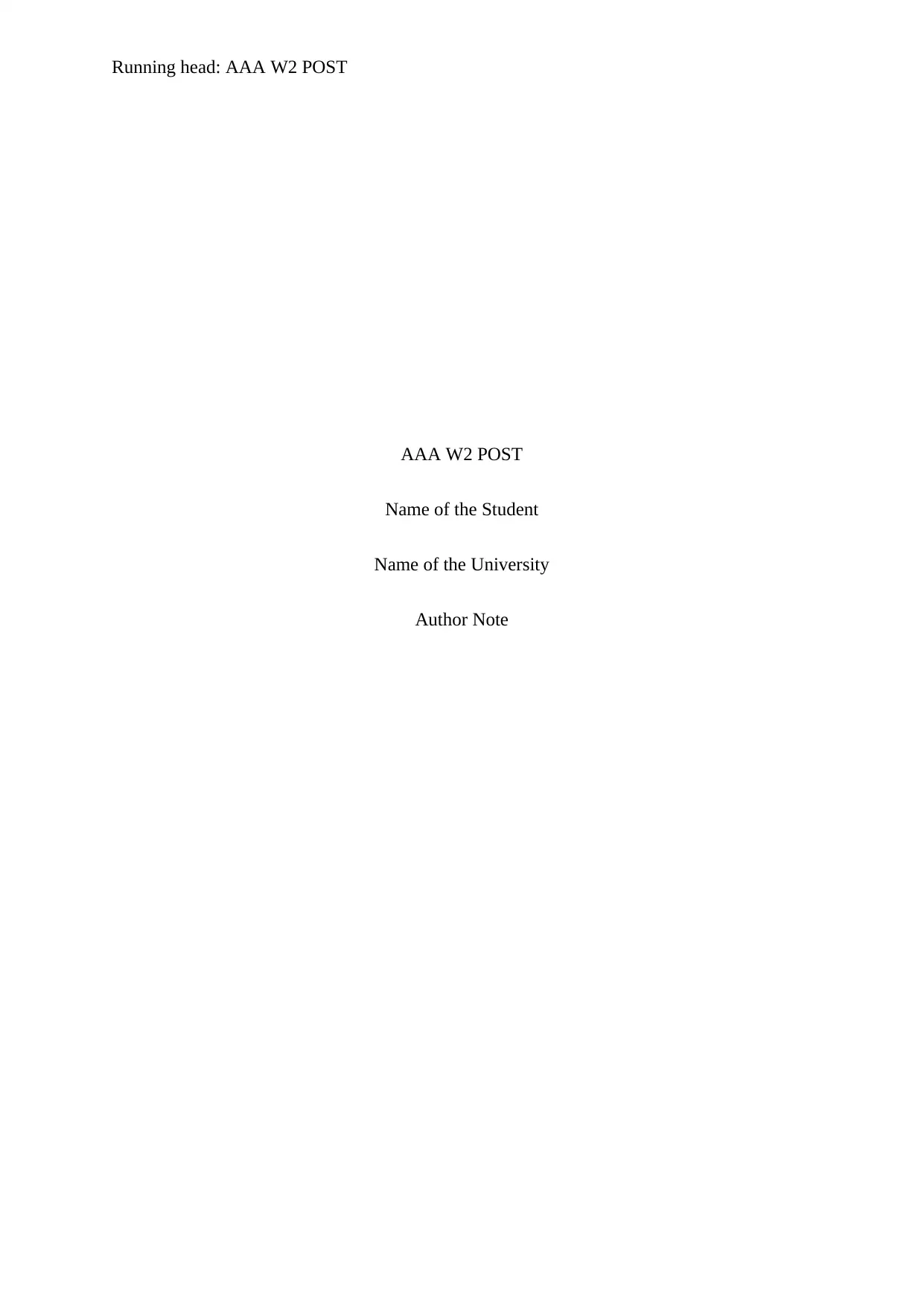
Running head: AAA W2 POST
AAA W2 POST
Name of the Student
Name of the University
Author Note
AAA W2 POST
Name of the Student
Name of the University
Author Note
Paraphrase This Document
Need a fresh take? Get an instant paraphrase of this document with our AI Paraphraser
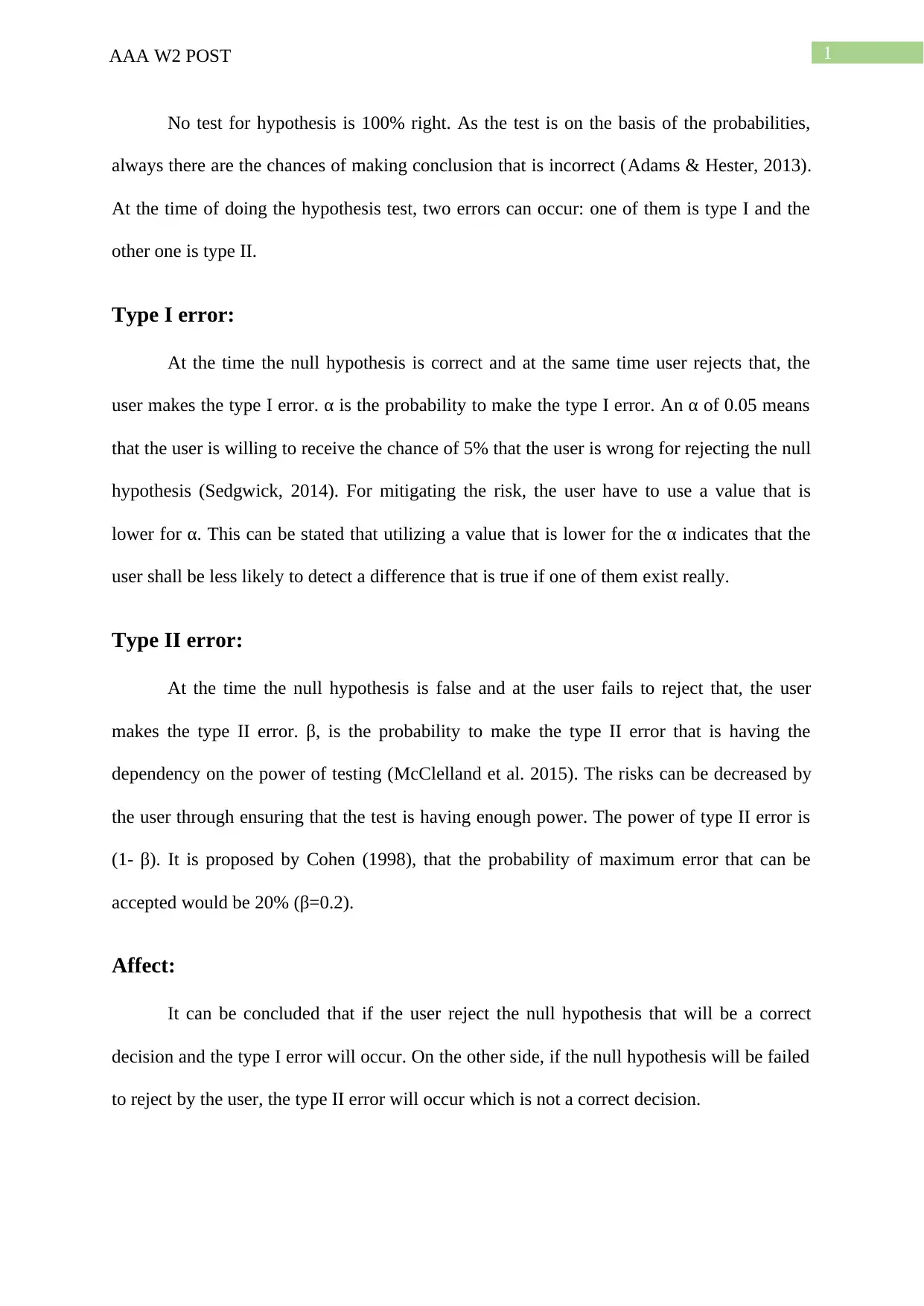
AAA W2 POST 1
No test for hypothesis is 100% right. As the test is on the basis of the probabilities,
always there are the chances of making conclusion that is incorrect (Adams & Hester, 2013).
At the time of doing the hypothesis test, two errors can occur: one of them is type I and the
other one is type II.
Type I error:
At the time the null hypothesis is correct and at the same time user rejects that, the
user makes the type I error. α is the probability to make the type I error. An α of 0.05 means
that the user is willing to receive the chance of 5% that the user is wrong for rejecting the null
hypothesis (Sedgwick, 2014). For mitigating the risk, the user have to use a value that is
lower for α. This can be stated that utilizing a value that is lower for the α indicates that the
user shall be less likely to detect a difference that is true if one of them exist really.
Type II error:
At the time the null hypothesis is false and at the user fails to reject that, the user
makes the type II error. β, is the probability to make the type II error that is having the
dependency on the power of testing (McClelland et al. 2015). The risks can be decreased by
the user through ensuring that the test is having enough power. The power of type II error is
(1- β). It is proposed by Cohen (1998), that the probability of maximum error that can be
accepted would be 20% (β=0.2).
Affect:
It can be concluded that if the user reject the null hypothesis that will be a correct
decision and the type I error will occur. On the other side, if the null hypothesis will be failed
to reject by the user, the type II error will occur which is not a correct decision.
No test for hypothesis is 100% right. As the test is on the basis of the probabilities,
always there are the chances of making conclusion that is incorrect (Adams & Hester, 2013).
At the time of doing the hypothesis test, two errors can occur: one of them is type I and the
other one is type II.
Type I error:
At the time the null hypothesis is correct and at the same time user rejects that, the
user makes the type I error. α is the probability to make the type I error. An α of 0.05 means
that the user is willing to receive the chance of 5% that the user is wrong for rejecting the null
hypothesis (Sedgwick, 2014). For mitigating the risk, the user have to use a value that is
lower for α. This can be stated that utilizing a value that is lower for the α indicates that the
user shall be less likely to detect a difference that is true if one of them exist really.
Type II error:
At the time the null hypothesis is false and at the user fails to reject that, the user
makes the type II error. β, is the probability to make the type II error that is having the
dependency on the power of testing (McClelland et al. 2015). The risks can be decreased by
the user through ensuring that the test is having enough power. The power of type II error is
(1- β). It is proposed by Cohen (1998), that the probability of maximum error that can be
accepted would be 20% (β=0.2).
Affect:
It can be concluded that if the user reject the null hypothesis that will be a correct
decision and the type I error will occur. On the other side, if the null hypothesis will be failed
to reject by the user, the type II error will occur which is not a correct decision.
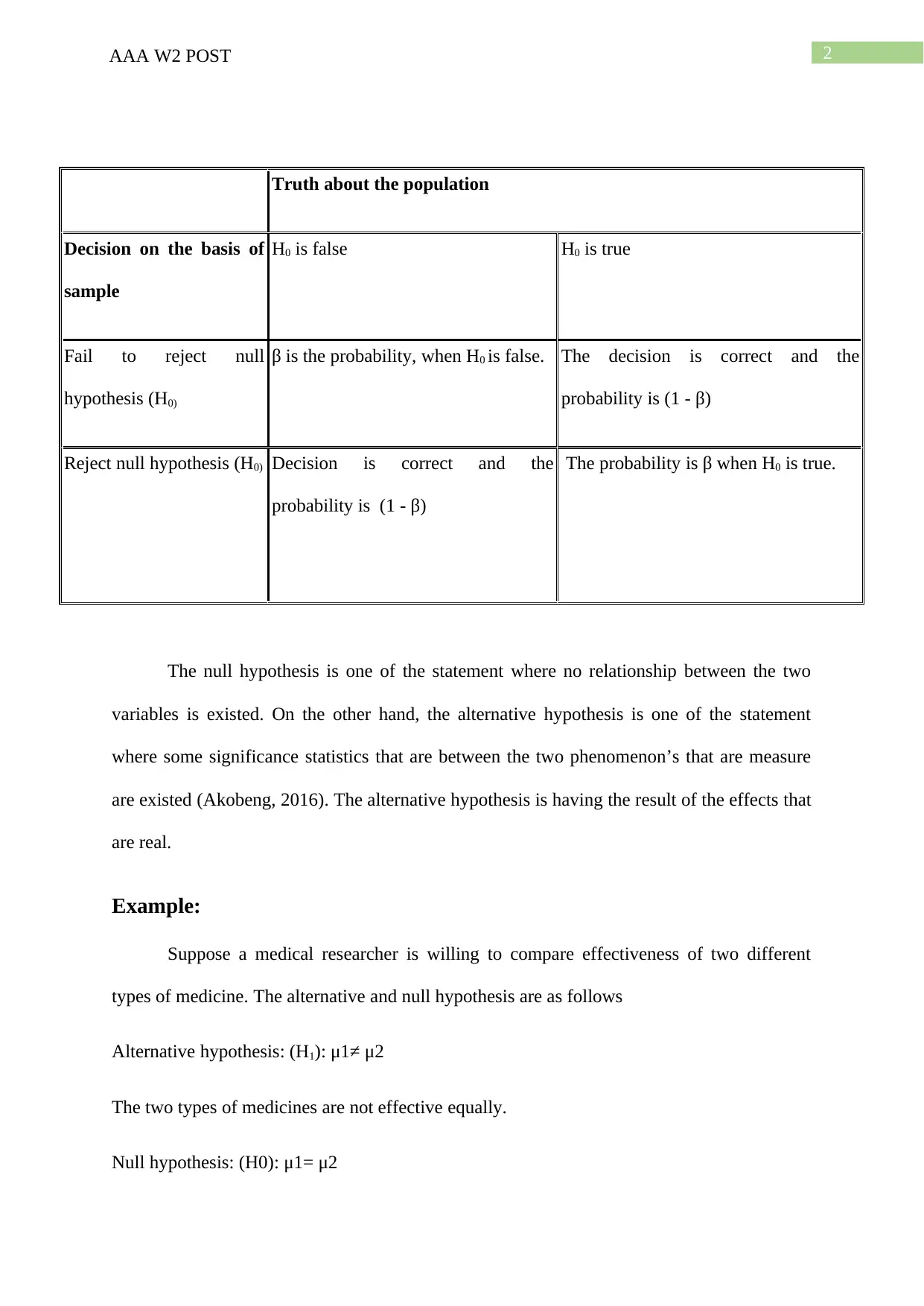
2AAA W2 POST
Truth about the population
Decision on the basis of
sample
H0 is false H0 is true
Fail to reject null
hypothesis (H0)
β is the probability, when H0 is false. The decision is correct and the
probability is (1 - β)
Reject null hypothesis (H0) Decision is correct and the
probability is (1 - β)
The probability is β when H0 is true.
The null hypothesis is one of the statement where no relationship between the two
variables is existed. On the other hand, the alternative hypothesis is one of the statement
where some significance statistics that are between the two phenomenon’s that are measure
are existed (Akobeng, 2016). The alternative hypothesis is having the result of the effects that
are real.
Example:
Suppose a medical researcher is willing to compare effectiveness of two different
types of medicine. The alternative and null hypothesis are as follows
Alternative hypothesis: (H1): μ1≠ μ2
The two types of medicines are not effective equally.
Null hypothesis: (H0): μ1= μ2
Truth about the population
Decision on the basis of
sample
H0 is false H0 is true
Fail to reject null
hypothesis (H0)
β is the probability, when H0 is false. The decision is correct and the
probability is (1 - β)
Reject null hypothesis (H0) Decision is correct and the
probability is (1 - β)
The probability is β when H0 is true.
The null hypothesis is one of the statement where no relationship between the two
variables is existed. On the other hand, the alternative hypothesis is one of the statement
where some significance statistics that are between the two phenomenon’s that are measure
are existed (Akobeng, 2016). The alternative hypothesis is having the result of the effects that
are real.
Example:
Suppose a medical researcher is willing to compare effectiveness of two different
types of medicine. The alternative and null hypothesis are as follows
Alternative hypothesis: (H1): μ1≠ μ2
The two types of medicines are not effective equally.
Null hypothesis: (H0): μ1= μ2
⊘ This is a preview!⊘
Do you want full access?
Subscribe today to unlock all pages.

Trusted by 1+ million students worldwide
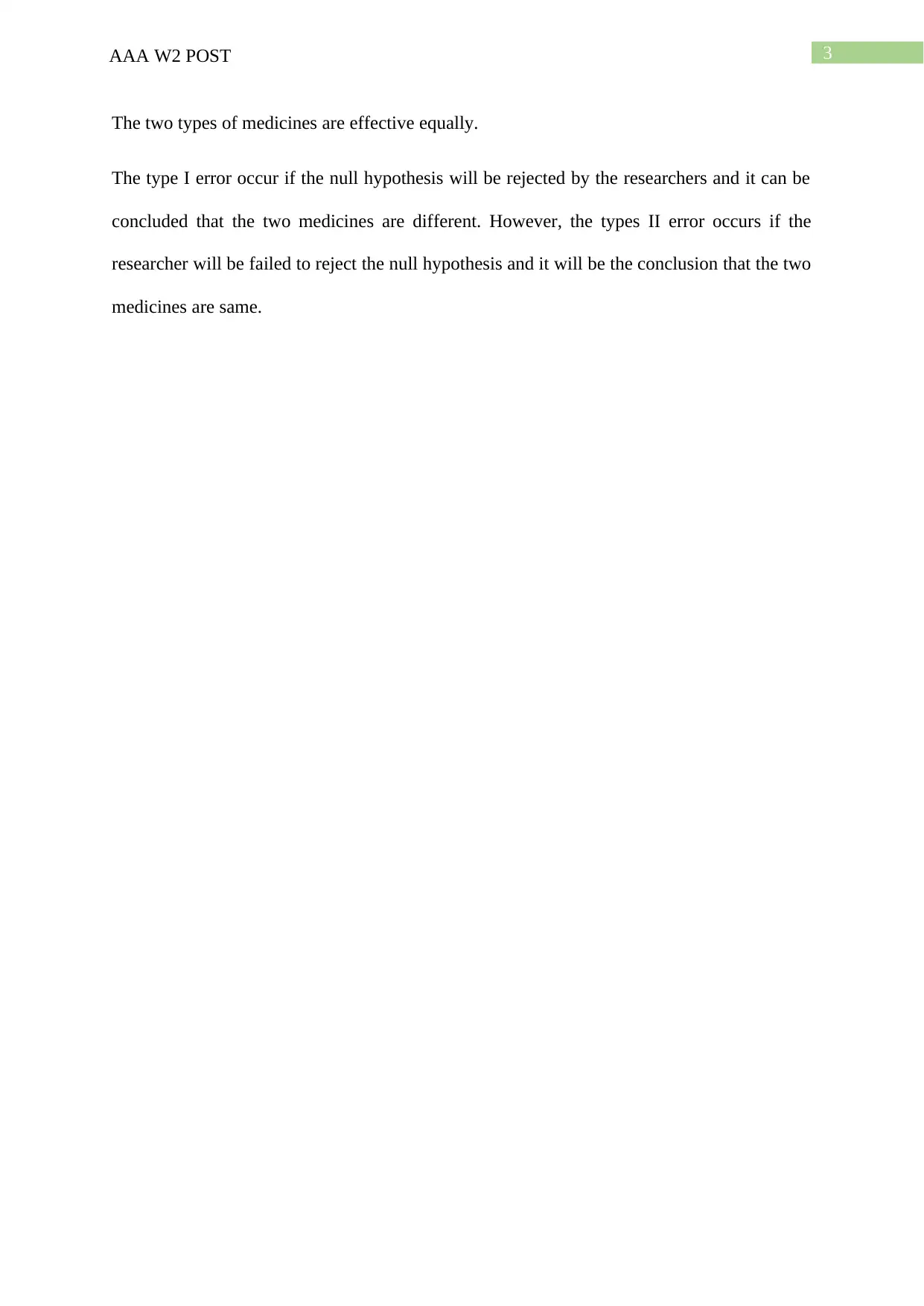
3AAA W2 POST
The two types of medicines are effective equally.
The type I error occur if the null hypothesis will be rejected by the researchers and it can be
concluded that the two medicines are different. However, the types II error occurs if the
researcher will be failed to reject the null hypothesis and it will be the conclusion that the two
medicines are same.
The two types of medicines are effective equally.
The type I error occur if the null hypothesis will be rejected by the researchers and it can be
concluded that the two medicines are different. However, the types II error occurs if the
researcher will be failed to reject the null hypothesis and it will be the conclusion that the two
medicines are same.
Paraphrase This Document
Need a fresh take? Get an instant paraphrase of this document with our AI Paraphraser
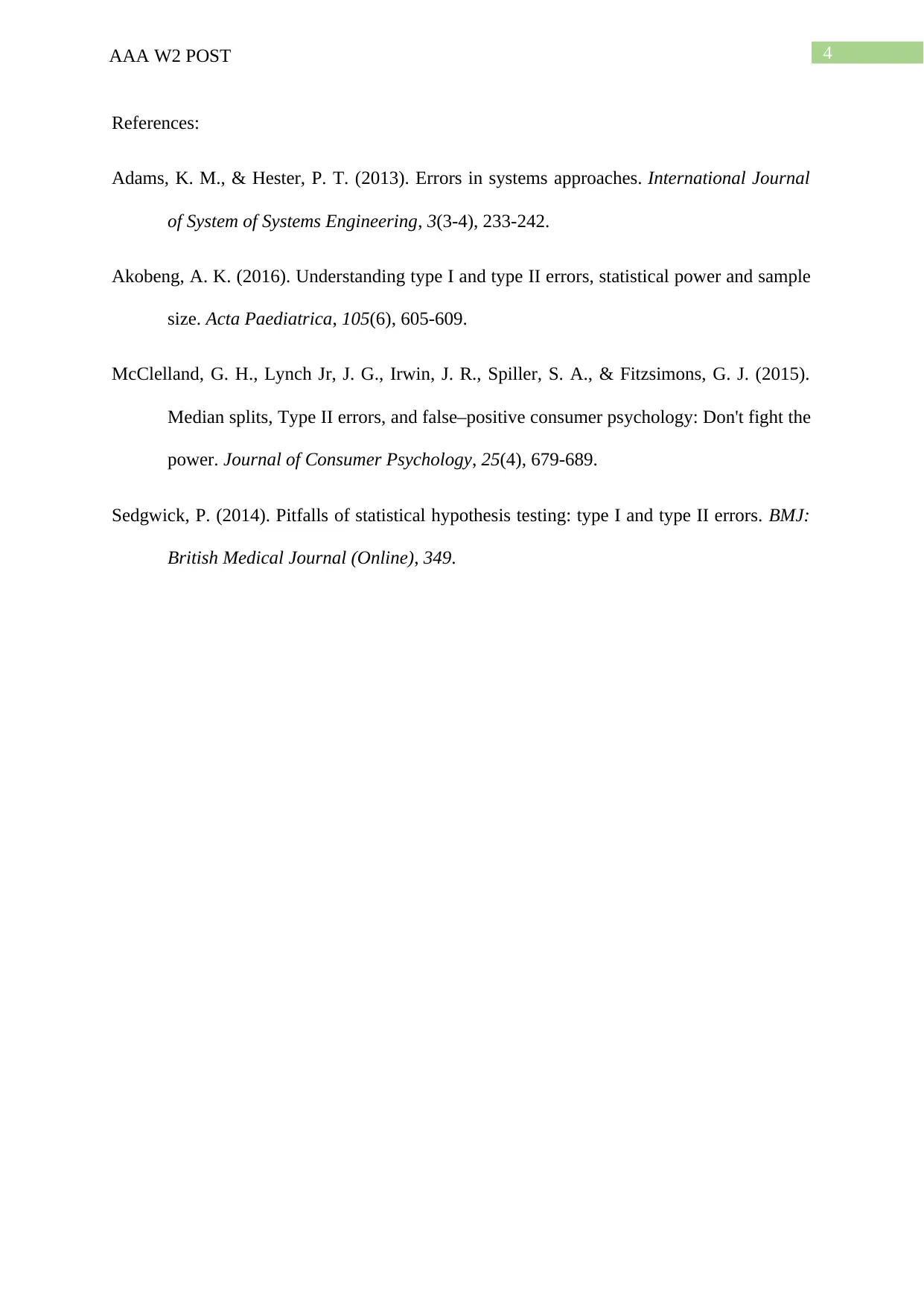
4AAA W2 POST
References:
Adams, K. M., & Hester, P. T. (2013). Errors in systems approaches. International Journal
of System of Systems Engineering, 3(3-4), 233-242.
Akobeng, A. K. (2016). Understanding type I and type II errors, statistical power and sample
size. Acta Paediatrica, 105(6), 605-609.
McClelland, G. H., Lynch Jr, J. G., Irwin, J. R., Spiller, S. A., & Fitzsimons, G. J. (2015).
Median splits, Type II errors, and false–positive consumer psychology: Don't fight the
power. Journal of Consumer Psychology, 25(4), 679-689.
Sedgwick, P. (2014). Pitfalls of statistical hypothesis testing: type I and type II errors. BMJ:
British Medical Journal (Online), 349.
References:
Adams, K. M., & Hester, P. T. (2013). Errors in systems approaches. International Journal
of System of Systems Engineering, 3(3-4), 233-242.
Akobeng, A. K. (2016). Understanding type I and type II errors, statistical power and sample
size. Acta Paediatrica, 105(6), 605-609.
McClelland, G. H., Lynch Jr, J. G., Irwin, J. R., Spiller, S. A., & Fitzsimons, G. J. (2015).
Median splits, Type II errors, and false–positive consumer psychology: Don't fight the
power. Journal of Consumer Psychology, 25(4), 679-689.
Sedgwick, P. (2014). Pitfalls of statistical hypothesis testing: type I and type II errors. BMJ:
British Medical Journal (Online), 349.
1 out of 5
Related Documents
Your All-in-One AI-Powered Toolkit for Academic Success.
+13062052269
info@desklib.com
Available 24*7 on WhatsApp / Email
![[object Object]](/_next/static/media/star-bottom.7253800d.svg)
Unlock your academic potential
Copyright © 2020–2025 A2Z Services. All Rights Reserved. Developed and managed by ZUCOL.




